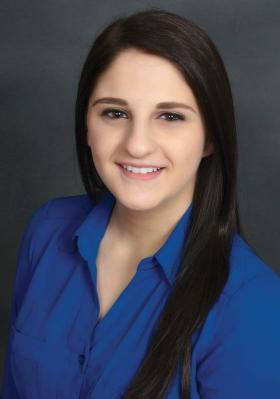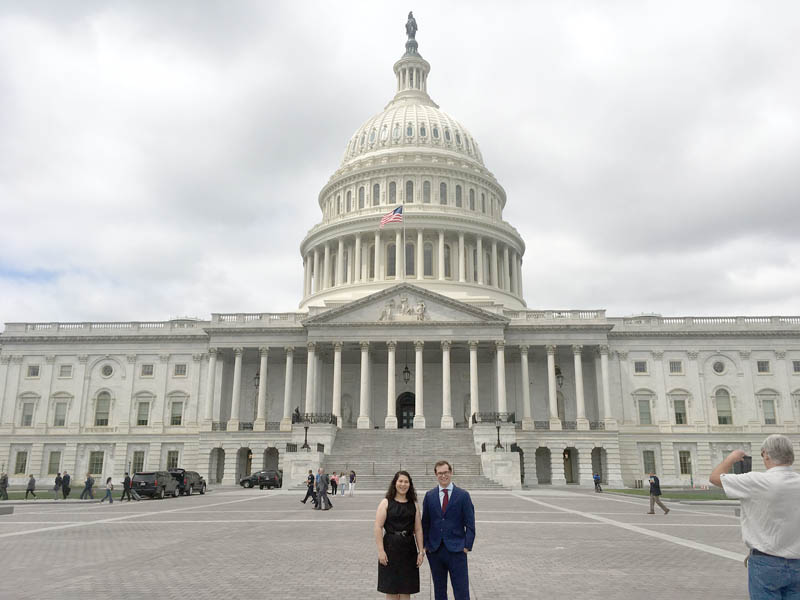Science Policy And Conducting a Congressional Visit
Summer
2017
Special Feature
Science Policy And Conducting a Congressional Visit
 As an associate zone councilor (AZC), I was given the opportunity to participate in Science–Engineering–Technology (SET) Congressional Visits Day and speak with my elected officials about topics that I care deeply about. In my case, I care about funding national science programs. Being a woman in physics, I often struggled with imposter syndrome, where I felt as if I did not belong. After attending a Conference for Undergraduate Women in Physics (CUWiP), I attended workshops that touched on these struggles of being a minority in STEM and how to overcome them. These workshops were a crucial step in continuing my career in STEM, but they wouldn’t have been possible without funding from the National Science Foundation (NSF).
As an associate zone councilor (AZC), I was given the opportunity to participate in Science–Engineering–Technology (SET) Congressional Visits Day and speak with my elected officials about topics that I care deeply about. In my case, I care about funding national science programs. Being a woman in physics, I often struggled with imposter syndrome, where I felt as if I did not belong. After attending a Conference for Undergraduate Women in Physics (CUWiP), I attended workshops that touched on these struggles of being a minority in STEM and how to overcome them. These workshops were a crucial step in continuing my career in STEM, but they wouldn’t have been possible without funding from the National Science Foundation (NSF).
When I met with my representatives and senators, I wanted to get the message across that funding science programs through organizations like the NSF is crucial to maintaining a diverse generation of scientists and engineers. My job was to give a face to a cause. I told them my personal story about how conferences like CUWiP saved my career as a minority in STEM. It is important for politicians to understand the personal impact their decisions have on their constituents.
I found that the representatives were genuinely intrigued by my experiences, regardless of their political views. My advice is to take advantage of this emotional connection. Also, be prepared and enthusiastic. The act of reaching out to politicians can be intimidating at first, but be confident in your story and passionate about your cause!
Part of being in a professional association like SPS or one of AIP’s Member Societies means that you have an amplified voice when it comes to reaching out to elected officials. Be sure to take advantage of this important member benefit and support your association’s advocacy efforts.
How to arrange a Congressional Visit Day:
1. First things first:
Pick a date. If you are going to meet your representatives in DC, be sure that Congress is in session. For an up-to-date calendar, visit https://www.congress.gov/days-in-session. You can also meet with your elected officials in their home office. Visit their website for more information.
2. At least 6 weeks out:
- Begin to consider what your message will be. Is there a specific bill you would like your elected officials to vote a certain way on or co-sponsor? Can you provide specific examples of ways they can impact an issue you face?
- Order business cards for yourself, including your name, affiliations, email, and phone number.
- Make your travel arrangements.
3. About 3 weeks out:
Begin calling and/or emailing offices. (You can find your representatives’ phone numbers on their websites.) A good phone script would be:
“Good morning/afternoon.
My name is [Name], I live in [City, State], and I am a constituent of [Senator/Rep’s name]. I am calling today as a member of the Society of Physics Students chapter at [School name]. I will be in Washington, DC, on [Dates] and would like to speak with the scheduler about setting up a meeting at [Time]. Can you tell me the scheduler’s name and connect me?”
If you are connected
Restate the information above and describe the issue you would like to talk about (e.g., “I would like to speak with the [Senator/Rep] about the importance of funding for Research
Experiences for Undergraduates via the National Science Foundation.”) Don’t be disappointed if your senator or representative is unavailable. Ask if you can meet with their staff person on science issues instead.
If they are not able to connect you
Get the name and email address of the scheduler and follow up with an email:
TO: [Scheduler]
CC: [Staff person]
SUBJECT: Constituent Meeting Request [date] at [time]
Dear [Senator, Congressman, or Congresswoman] [FULL NAME]:
My name is [FULL NAME] of [City, State where you are registered to vote], and I would like to request an appointment with you on [Date] at [Time].
I am a physics student at [University Name] and would like to speak with you about your support for the sciences and STEM education. I will be in [Washington, or City with home district office] with my fellow students and professors to raise visibility and support for science, engineering, and technology.
Thank you,
[FULL NAME]
[Phone number]
[Email address]
Start building your schedule. Allot approximately 30 minutes for each meeting.
4. Two weeks out:
- Follow up with any of the offices you haven’t heard from yet—be polite, yet persistent, and don’t give up!
- Refine your elevator pitch. There are lots of resources out there on how to craft an engaging and persuasive pitch that will open the door to conversation. Think about what your specific asks will be for your elected official. Wear a clean business suit and neat, comfortable shoes.
- Consider developing a one-page “leave behind” that summarizes your key points and gives the person you are meeting with a concrete reminder of your priorities.
5. One week out:
- Practice, practice, practice your elevator pitch. You should feel very comfortable with your speech and be able to give it in an engaging way without any notes.
- Follow up with any offices you have not yet heard from.
6. Day of:
- Eat a good breakfast, pay attention to your wardrobe, and get ready to take on Capitol Hill!
- Arrive at each of your offices a few minutes early.
- Get business cards from everyone you meet.
- Take breaks throughout the day to get food and reflect on what you’ve heard.
- Enjoy! This is a unique opportunity to engage with people who have been elected to serve you! Take the time to share your story, ask your questions, and know that you are making an impact on future policy.

